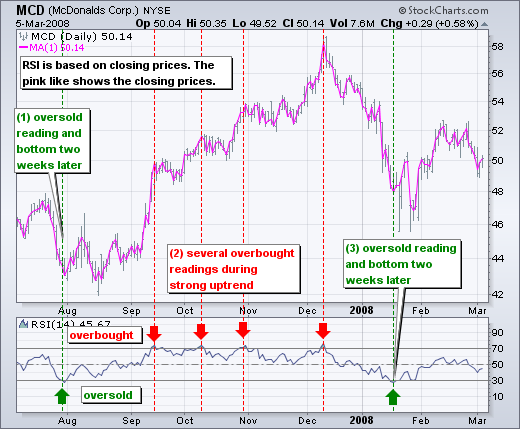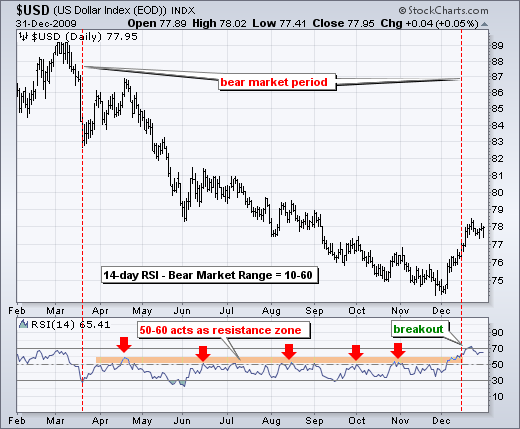

The discussion of overbought and oversold levels, and the way the RSI works has been quite general so far. The RSI close to 100, usually above the 70 threshold, can then be considered as a sign of a potential local top and we call levels over 70 “ overbought” as there might not be much buying left. And so, extreme buying might be a contrarian indication of a local top. But it might just be the case that the buying power is drying up – when there’s been a lot buying going on, almost everybody willing to buy might have already done so and there might not be much buying left. The RSI obliges and follows suit in the direction of 100. The flip side is that in times of excessive optimism or buoyant buying, the prices tend to go up a lot. Traditionally, levels below 30 are considered oversold and taken as a potential indication of a local bottom. We would call very low RSI levels “ oversold” as there might not be more selling left. In this sense, the RSI can be viewed as a gauge of whether a lot of selling has happened in the market.

They are also periods when the RSI readings are likely to be extremely low. Panic or selling can be contrarian signals. However, it is also a quite well known adage that “it’s best buy when there’s blood in the streets.” The times of extreme pessimism, selling and turmoil in the market can also be times when there’s not much more selling left as almost everybody willing to sell has already done so. For instance, in times of panic prices tend to drop like a stone. The importance of the RSI can be linked to the fact that extreme market conditions will usually lead to extreme readings on the RSI. Significant or prolonged appreciation will propel the RSI closer to 100.
.png)

Significant or prolonged declines in the price will drive the RSI closer to 0. The way the RSI operates is mostly that the indicator falls when the price of the asset itself falls, and rises when the price of the asset rises. These past prices are used to calculate a number between 0 and 100. The basic principle on which the RSI operates is that it is based on historical prices of an asset. Prices usually correct and move in the direction of the RSI.You’re welcome. The Relative Strength Index shows, sometimes more clearly than price themselves, levels of support and resistance.Īs discussed above, divergences occur when the price makes a new high (or low) that is not confirmed by a new high (or low) in the Relative Strength Index. This is where the Relative Strength Index surpasses a previous high (peak) or falls below a recent low (trough). Failure Swing (Support or Resistance breakout).The RSI often forms chart patterns such as head and shoulders or triangles that may be or may not be visible on the price chart. It usually forms these tops and bottoms before the underlying price chart. The Relative Strength Index usually tops above 70 and bottoms below 30. The following signals of Relative Strength Index are used in chart analyzing: The failure swing is considered a confirmation of the impending reversal. When the Relative Strength Index then turns down and falls below its most recent trough, it is said to have completed a "failure swing". This divergence is an indication of an impending reversal. A popular method of analyzing the RSI is to look for a divergence in which the security is making a new high, but the RSI is failing to surpass its previous high. Since then, the 9-period and 25-period Relative Strength Index indicators have also gained popularity. When Wilder introduced the Relative Strength Index, he recommended using a 14-period RSI. The Relative Strength Index Technical Indicator (RSI) is a price-following oscillator that ranges between 0 and 100. Request a presentation of MetaTrader 5 for Hedge Funds.Request a presentation of MetaTrader 5 for Brokers.


 0 kommentar(er)
0 kommentar(er)
